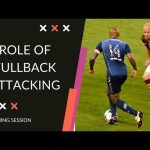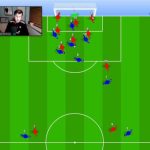In the world of soccer, defensive headers play a crucial role in protecting the goal and ensuring victory for the team. However, building strength specifically for these high-pressure moments can be a challenge for athletes. With the right training techniques and exercises, defenders can enhance their aerial abilities, boost their confidence, and become an unstoppable force on the field. In this article, we will explore key strategies and workouts that will help players develop the power and precision needed to dominate in defensive headers. Get ready to elevate your game and solidify your position as a formidable force in the air.
Advantages
- Improved Upper Body Strength: Regularly practicing defensive headers can help build strength in your upper body, including your neck, shoulders, and chest. This increased strength can make it easier to resist opponents’ attempts to push you around during aerial challenges and provide a solid foundation for executing powerful defensive headers.
- Enhanced Neck Stability: Building strength for defensive headers can also improve the stability of your neck muscles. This is particularly important when engaging in aerial battles, as a strong and stable neck can help you maintain proper body positioning while heading the ball. Having good neck stability can reduce the risk of neck injuries and improve your overall performance in defensive situations.
- Increased Confidence: By consistently working on building strength for defensive headers, you can develop a sense of confidence in your ability to protect your team’s goal. Knowing that you have the physical strength and stability to effectively execute defensive headers can give you the mental edge needed to challenge opponents in the air without hesitation. This confidence can positively impact your overall defensive game and make you a more valuable asset to your team.
Disadvantages
- Increased risk of injury: Building strength for defensive headers can involve repetitive and forceful movements that put strain on the neck, shoulders, and upper body. This can increase the risk of injuries such as muscle strains, sprains, or even concussions.
- Limited focus on other skills: When solely focusing on building strength for defensive headers, players may neglect other important skills necessary for overall performance in the game. This can lead to imbalances in their abilities and hinder their overall development as a well-rounded player.
- Over-reliance on headers: Relying too heavily on defensive headers as a defensive strategy can limit a player’s ability to effectively defend in other ways, such as intercepting passes, tackling, or positioning themselves properly. This can make the player predictable and easier to exploit by opponents who can adjust their tactics accordingly.
- Decreased agility and mobility: Building excessive strength for defensive headers can sometimes result in a decrease in agility and mobility. This can affect a player’s ability to quickly change direction, react to unexpected situations, or keep up with faster opponents. A lack of agility and mobility can make it harder to effectively defend against different types of attacks or contribute to the team’s overall defensive efforts.
How can I improve my skills in winning headers?
To improve your ability to win headers, it is crucial to focus on timing and technique. If you find that your headers lack power, it is likely due to jumping too early. Ensure that you make contact with the ball at the peak of your jump, maximizing your height and generating more force. While it is important to jump first, be cautious not to jump too early, as this can result in a weaker header. By mastering the art of timing your jump correctly, you can enhance your chances of winning headers and dominating in aerial duels.
How can I improve my skills as a defensive end?
If you want to improve your skills as a defensive end, there are a few key areas you should focus on. First and foremost, work on your speed and agility. Defensive ends need to be able to quickly react and change directions to keep up with offensive players. Incorporate drills that enhance your footwork and explosiveness into your training regimen. Additionally, honing your technique is crucial. Develop a strong understanding of different blocking schemes and learn how to effectively use your hands to shed blocks. Practice proper tackling form and work on your pass-rushing moves to become a more versatile and impactful defensive end.
To truly excel as a defensive end, it is crucial to have a strong mental game. Football is as much a mental sport as it is physical, and being able to read and anticipate plays will give you an edge on the field. Study film footage of your opponents to gain insights into their tendencies and develop strategies to counter them. Furthermore, work on your discipline and patience. Defensive ends often face double teams and need to maintain their positioning and discipline to effectively disrupt plays. By focusing on improving your physical abilities, technique, and mental acuity, you can become a formidable force as a defensive end.
How can headers in EAFC be defended?
In EAFC, defending headers requires a combination of strategic positioning, timing, and strong aerial abilities. As the opposing team launches crosses and set pieces towards the goal, defenders must be proactive in anticipating the trajectory of the ball and positioning themselves accordingly. By analyzing the opponent’s playing style and studying their key players, defenders can effectively mark their assigned opponents and cut off their aerial threats. Additionally, timing plays a crucial role in defending headers as defenders must jump at the right moment to challenge their opponents in the air and disrupt their attempt at scoring. Developing strong aerial abilities through regular practice and improving jumping technique further enhances a defender’s capability to defend headers successfully. Overall, a comprehensive approach that includes strategic positioning, timing, and strong aerial abilities is essential in defending headers in EAFC.
A Header’s Secret Weapon: Unleashing Your Defensive Power
A header in soccer is not just a simple act of redirecting the ball; it is a secret weapon that can unleash your defensive power on the field. The technique requires precision, timing, and strategy. As the ball hurtles towards you, you must anticipate its trajectory, position your body correctly, and make contact with the perfect combination of power and finesse. With a well-executed header, you can clear the ball from dangerous areas, disrupt your opponent’s attacks, and instill fear in the hearts of your adversaries. The header is not only a defensive tool but also a statement of your dominance and authority on the pitch. So, next time you find yourself in a position to head the ball, remember to unleash your defensive power and make your mark on the game.
Fueling Success: Strengthening Your Defensive Header Skills
Fueling Success: Strengthening Your Defensive Header Skills
Paragraph 1:
Mastering the art of defensive headers is essential for every soccer player aiming to excel on the field. A solid defense is the backbone of any successful team, and a well-executed header can be a game-changer. By learning and honing your defensive header skills, you can become an invaluable asset to your team, contributing to their victories and overall success. Whether you are a seasoned player or just starting out, dedicating time and effort to improving your defensive headers will undoubtedly fuel your success on the soccer field.
Paragraph 2:
Defensive headers require a combination of technique, timing, and precision. It is crucial to develop the ability to anticipate the trajectory of the incoming ball and position yourself accordingly. Maintaining a strong and stable body position is key to executing a powerful header. By keeping your eyes on the ball, maintaining a solid stance, and using the appropriate amount of force, you can effectively defend against opposing team’s attacks and clear the ball out of your defensive zone. Regular practice drills focusing on defensive headers will enhance your skills and ensure that you become a formidable force in the game.
Paragraph 3:
While defensive headers are often associated with tall and physically strong players, it is a skill that can be mastered by anyone with dedication and practice. Height, although advantageous, is not the sole determining factor for success in defensive headers. By developing your timing, reading the game, and implementing proper technique, you can compensate for height differences and overcome any physical disadvantages. Remember, it’s not just about winning the aerial battle, but also about directing the ball to a teammate or creating an opportunity for a counter-attack. By continuously working on your defensive header skills, you can become a vital part of your team’s defensive strategy and contribute significantly to their overall success.
Unlocking Your Potential: Building Strength for Dominant Defensive Headers
Unlocking Your Potential: Building Strength for Dominant Defensive Headers
Paragraph 1:
In the world of soccer, dominance on the defensive end can make or break a game. One key aspect of defensive play is the ability to win headers and clear the ball effectively. To unlock your potential and become a dominant force in the air, building strength is crucial. By incorporating targeted exercises that focus on the muscles used during defensive headers, you can enhance your power, control, and overall effectiveness in this vital aspect of the game.
Paragraph 2:
To build strength for dominant defensive headers, it is important to prioritize exercises that target the core and upper body. Strengthening the core muscles, including the abdominals and lower back, will provide a solid foundation for generating power and stability during aerial challenges. Additionally, exercises that focus on the muscles in the shoulders, neck, and upper back will enhance your ability to generate force and maintain control while contesting for headers. Incorporating exercises such as planks, push-ups, shoulder presses, and pull-ups into your training regimen can help you develop the necessary strength to outmuscle your opponents in the air.
Paragraph 3:
Aside from targeted exercises, proper technique and timing are essential for successful defensive headers. It is crucial to work on your jumping technique, ensuring you have a strong takeoff and can generate maximum power from your legs. Timing is also crucial, as you need to anticipate the flight of the ball and position yourself effectively to win the header. Practice drills that simulate game situations and focus on timing your jumps to intercept crosses or clear the ball from dangerous areas. By combining strength-building exercises with technical training, you can unlock your potential and become a dominant force in defensive headers, giving your team a significant advantage on the field.
Incorporating effective training techniques and adopting proper body mechanics are essential for building strength in preparation for defensive headers. By focusing on exercises that target the neck, shoulder, and core muscles, players can enhance their ability to withstand the impact of aerial challenges with confidence. Furthermore, maintaining a consistent training regimen and practicing correct technique during gameplay will contribute to an overall improvement in defensive header performance. With these strategies in place, players can fortify their physical capabilities and become formidable forces in the air, ensuring a strong defensive line for their team.



